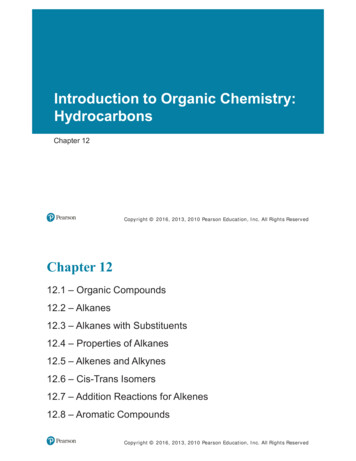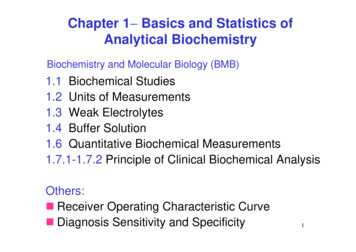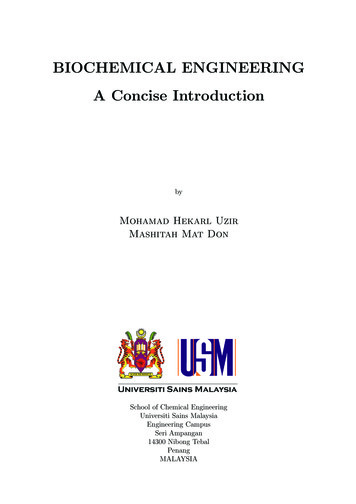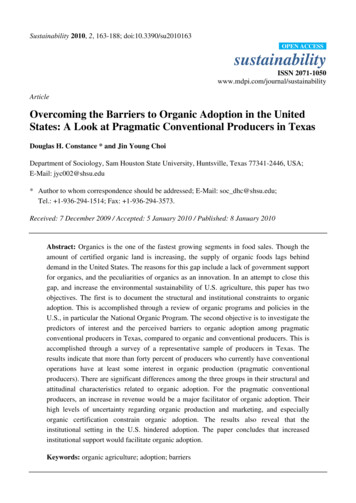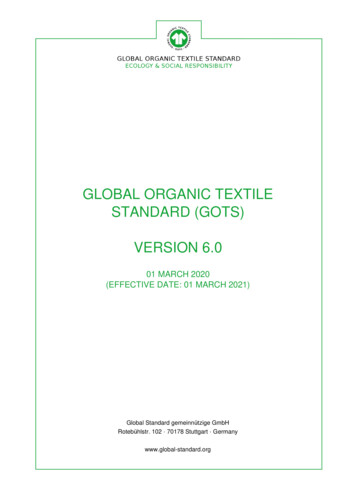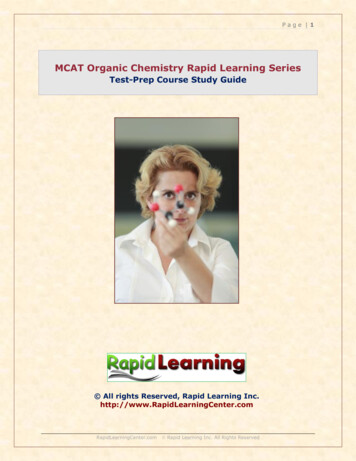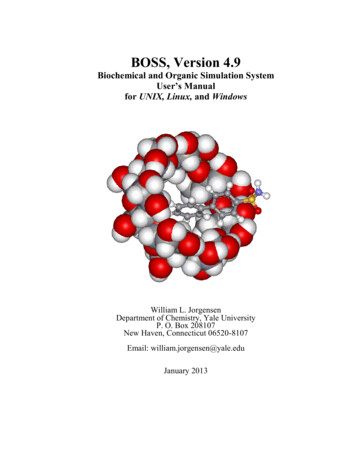
Transcription
BOSS, Version 4.9Biochemical and Organic Simulation SystemUser’s Manualfor UNIX, Linux, and WindowsWilliam L. JorgensenDepartment of Chemistry, Yale UniversityP. O. Box 208107New Haven, Connecticut 06520-8107Email: william.jorgensen@yale.eduJanuary 2013
ContentsPageIntroduction41Can’t Wait to Start – Use the x Scripts62Statistical Mechanics Simulation – Theory63Energy and Free Energy Evaluation74New Features95Operating Systems146Installation147Files148Command or bat File Input169Parameter File Input1810Z-matrix File .1110.1210.1332323232333333343536363737Atom InputGeometry VariationsBond Length VariationsAdditional BondsHarmonic RestraintsBond Angle VariationsAdditional Bond AnglesDihedral Angle VariationsAdditional Dihedral AnglesDomain DefinitionsConformational SearchingSample Z-matrixZ-matrix Input for Custom Solvents11PDB Input3912Coordinate Input in Mind Format and Reaction Path Following4013Pure Liquid Simulations4114Cluster Simulations412
15Solventless and Molecular Mechanics Continuum SimulationsEnergy MinimizationsDihedral Angle DrivingPotential Surface ScanningNormal Coordinate AnalysisConformational Searching16Available Solvent Boxes5117Ewald Summation for Long-Range Electrostatics5318Test Jobs5419Output6019.1 Some Variable Definitions6120Contents of the Distribution Files6321Appendix – No. of Molecules for Binary Solvent Mixtures6522Appendix - OPLS All-Atom Parameters663
Biochemical and Organic Simulation SystemIntroductionThe BOSS program performs (a) Monte Carlo (MC) statistical mechanics simulations forsolutions of zero to 25 solute molecules in a periodic solvent box, in a solvent cluster, or in adielectric continuum including the gas phase, and (b) standard energy minimizations,normal mode analysis, and conformational searching. The energetics are represented withthe OPLS force fields or the AM1, PM3, PDDG/PM3 and PDDG/MNDO semiempiricalmolecular orbital methods. Besides the quantitative structural and energetic results, otherquantities are computed including dipole moments, CM1 and CM3 atomic charges, solventaccessible surface areas, and hydrogen-bond counts that are valuable for many applicationssuch as structure-activity relations. Some important features are:1. For the Monte Carlo simulations, the NPT ensemble is employed, though NVTsimulations can also be performed by not allowing volume changes.2. Preferential sampling is used whereby the solutes and nearby solvent molecules aremoved more frequently than distant solvent molecules. The biasing is based on1/(r2 wkc) where wkc is a constant. See J. Phys. Chem. 87, 5311-5312 (1983).3. The solute coordinates can be provided by Z-matrix or PDB input and internalcoordinates are used to sample solute geometries. Initial solvent coordinates can comefrom stored, equilibrated boxes of solvent. Boxes of various sizes are currentlyprovided for eleven solvents. Other boxes with up to 3000 solvent molecules can beautomatically created. Binary solvent mixtures can also be treated. And, by giving aZ-matrix for a solvent molecule, any solvent or pure liquid can be simulated.4. Free energy changes are computed from statistical perturbation (FEP) theory.Applications can include computing free energies of solvation, reaction profiles,potentials of mean force (pmf's), and relative or absolute free energies of binding forhost/guest complexes. For examples of calculations with BOSS, see: free energies of hydration- J. Chem. Phys. 83, 3050 (1985);- J. Am. Chem. Soc. 121, 4827 (1999)- J. Comput. Chem. 35, 1322 (2004)linear response calculations - J. Phys. Org. Chem.10, 563 (1997);- J. Am. Chem. Soc. 122, 2878 (2000)partition coefficients- J. Phys. Chem. 94, 1683 (1990)relative acidities (pK’as)- J. Am. Chem. Soc. 111, 4190 (1989);- J. Phys. Chem. A 104, 7625 (2000)pmfs for ion pairs- J. Am. Chem. Soc. 111, 2507 (l989)for benzene dimer- J. Am. Chem. Soc. 112, 4768 (1990)for amide dimers- J. Am. Chem. Soc. 111, 3770 (1989)reaction profiles- ACS Symp. Ser. 721, 74 (1999)- J. Am. Chem. Soc. 114, 10966 (1992)- J. Am. Chem. Soc. 119, 12982 (1997)conformational equilibria- J. Phys. Chem. 91, 6083 (1987)- J. Am. Chem. Soc. 114, 7535 (1992)- J. Am. Chem. Soc. 116, 2199 (1994)4
host/guest binding clustersfor reviews, see: QM/MM calculations GB/SA modelpolarizable potentials- J. Org. Chem. 64, 7439 (1999)- J. Am. Chem. Soc. 120, 5104 (1998)- Proc. Natl. Acad. Sci. USA 90, 1194 (1993)- Bioorg. Med. Chem. 17, 5874 (2009)- J. Chem. Phys. 99, 4233 (1993)- Acc. Chem. Res. 22, 184 (1989)- Encyclopedia Comp. Chem. 2, 1061 (1998)- J. Phys. Chem. B 102, 1787 (1998)- J. Phys. Chem. B 106, 8078 (2002)- J. Am. Chem. Soc. 126, 9054 (2004)- J. Chem. Theory Comput. 3, 132, 1412 (2007)- J. Am. Chem. Soc. 132, 3097, 8766 (2010)- Acc. Chem. Res. 43, 142-151 (2010) (review)- J. Phys. Chem. B 108, 16264 (2004)- J. Chem. Theory Comput. 3, 1987 (2007)- J. Phys. Chem. B 114, 8425 (2010)5. The OPLS united-atom (J. Am. Chem. Soc. 110, 1657 (1988)) and all-atom (J. Am.Chem. Soc. 118, 11225 (1996)) potential functions are used with additional referencesgiven in the parameter files. Coverage includes numerous organic functional groups, allcommon peptide residues, and nucleotides. More parameters can easily be added to theparameter file. Unpublished parameters including for heterocycles, sulfonamides, andother pharmacologically important groups are also provided to BOSS users.Alternatively, the energetics of the solute(s) can be described with the AM1, PM3,PDDG/PM3 or PDDG/MNDO semiempirical molecular orbital methods. Any solventsolvent interactions are described with the OPLS potentials for mixed QM/MMcalculations. The solute-solvent interactions are described with the force field usingstandard OPLS-AA Lennard-Jones parameters for the solute(s) and solute chargesobtained from the CM1 or CM3 procedures or as Mulliken charges.6. Dihedral angles, bond angles and bond lengths in the solutes can be sampled during thesimulations, e.g., a pmf could be determined for the separation of two flexiblemolecules or binding to a flexible host could be studied. The solvent molecules canalso be fully flexible.7. Harmonic restraints can be included between pairs of solute atoms or between anatom and a fixed point. This facilitates some free energy calculations for host/guestsystems; it can also be used for restrained optimizations and NMR structure refinement.8. Coordinate files may be output in PDB or MDL mol format for easy display withstandard molecular graphics programs.OverviewAn extensive overview of BOSS and its capabilities has been published in J. Comput. Chem. 26,1689-1700 (2005). The reprint is included in the bossman directory as BOSS-MCPRO.JCC05.pdf5
1Can’t Wait to Start – Use the x ScriptsIf you want to use BOSS immediately after following the installation instructions, many scriptsare provided to execute standard jobs. All that is needed is a coordinate file (BOSS Z-matrix,.mol, .mol2, or .pdb). Hundreds of BOSS Z-matrix files (.z) are provided in the molecules/smalland molecules/drugs directories. The scripts are in the scripts directory and most are alsoduplicated in the molecules/small and molecules/drugs directories for Linux/UNIX; forWindows, all scripts are available in the boss shell. The scripts are described inboss/scripts/00README (%BOSSdir%\scripts\00README.doc under Windows) and cover manystandard jobs including energy minimizations with the OPLS force field or with AM1, PM3, orPDG (PDDG/PM3) calculations, conformational searching, and conversion of externalcoordinate files (.mol, .mol2, .pdb) to BOSS Z-matrix files (.z).Some examples follow. Output will be in the files out, sum, and plt.pdb. The output structure inplt.pdb can be displayed with any standard molecular graphics programs such as RasMol,WebLab Viewer, Chimera, etc. The sum file contains the output Z-matrix or a results summary.(1) Perform an energy minimization for butane with the OPLS-AA force field,cd /boss/molecules/small (for Windows: cd %BOSSdir%\molecules\small or just cda in a bossshell window)xOPT butanethen display output structure in plt.pdb viaxRAS(2) Perform a PDDG/PM3 optimization for AZT,cd /boss/molecules/drugs (for Windows: cd %BOSSdir%\molecules\drugs or just cdd)xPDB azt(display the structure in azt.z)xPDGOPT azt(optimize with PDDG/PM3)xRAS(display output structure; output Z-matrix is in sum)(3) Convert an MDL .mol file for Zoloft to a BOSS Z-matrix and optimize the structure. TheOPLS/CM1A force field is used. The file zoloft.z is created.cd /boss/molecules/small (or cda for Windows)xMOLZ zoloft(4) Perform a conformational search for alanine dipeptide using 100 random starting structuresand include GB/SA solvation. Output is in alanin.cs.out, and alanin.cs.sum, and the structures ofthe conformers are output in MDL .mol format in the file alanin.cs.molcd /boss/molecules/small(or cda for Windows)xCSGB100 alanin2Statistical Mechanics Simulations—TheoryStatistical mechanics simulations of many particle (e.g., condensed phase) systems are commonlydone by one of two main approaches, Monte Carlo (MC) and molecular dynamics (MD). Thebasic principles are similar, but the methodology is fundamentally different. Common to both isthe use of a classical energy function to calculate the total potential energy of the system as afunction of the bonds, bond angles, torsions, and interatomic interactions. The expression usedin BOSS is typical for molecular mechanics (MM) force fields:6
E total K r ( r r0 )bonds2 K ( 0 )angles 2 Aij C ij q i q jVn [1 cos(n )] 6torsions,n 2non bonded r 12 rijrij ij In a QM/MM calculation, the intrasolute and intersolute interaction terms are replaced by thetotal QM energy. Once the potential energy of the system is known, a MC simulation generates anew configuration by a set of random motions. The difference in energy between the new andthe old configuration is used as a selection criterion by the Metropolis algorithm, which enforcesa correct Boltzmann distribution of energies for the system at the desired temperature, and theprocedure is then iteratively repeated. The ensemble of configurations generated in this fashioncan be used to compute the structure and thermodynamic properties of the system at the specifiedconditions. Differences in free energies between two similar states of the system can becalculated from this ensemble through the use of statistical perturbation theory. In a MDsimulation, on the other hand, the forces from the energy components in the three Cartesiandirections acting on each atom are evaluated. The accelerations are calculated from these forces,and a trajectory is generated by the repeated numerical integration of the equations of motionover a period of time. This trajectory constitutes an ensemble of configurations that is formallyequivalent to an ensemble generated via a MC simulation and can be used in the same fashion.This difference in methodology, although it may not be obvious at first look, has significantimplications in the use and application of the methods. The major difference from an algorithmicpoint of view is that MC sampling can readily use internal coordinates, while MD works withindependent atomic motions in Cartesian space. The consequences of this difference are many;in MD it is easy to treat large, flexible molecules since any coupling between different degrees offreedom is automatically handled by the algorithm. On the other hand, the integration time stephas to be very small in order to avoid numerical instability and imprecision. There is also acertain inefficiency in the sampling since motions that go uphill in energy are usually reversed byopposing restoring forces. Also, the algorithm makes the selective freezing of unimportantdegrees of freedom cumbersome. In a MC calculation, on the other hand, the freezing of selectedinternal coordinates is easily accomplished by simply not allowing variations in the specifiedbonds, angles, or dihedrals; however, sampling for large flexible molecules can be problematicsince degrees of freedom are treated, for the most part, as being completely uncoupled. Anadditional advantage of MC is that it is possible to sample large regions of configurational spaceby stepping over potential energy barriers. A paper comparing the efficiencies of MD and MC insimulations of liquid hexane has appeared: W. L. Jorgensen & J. Tirado-Rives, J. Phys. Chem.100, 14508 (1996). In this case, MC was found to be 2-4 times more efficient for theconformational sampling.Summaries on the theory and computations can be found in the following paper along withreferences to more detailed presentations: W. L. Jorgensen, J. Phys. Chem. 87, 5304 (1983). Seealso: M. P. Allen and D. J. Tildesley, Computer Simulations of Liquids; Oxford U. Press:London, 1987.3Energy and Free Energy EvaluationIn BOSS, the total MM potential energy of a system is given by eq 1E ESS ESX EXX EBND EBC EANG EDIH ENB ECUT ESINT7(1)
whereESSESXEXXEBNDEBCEANGEDIHENBECUT the solvent-solvent energy, the solvent-solute energy, the solute-solute (intersolute) energy, the bond stretching energy for the solutes, the energy for the harmonic restraints, the angle bending energy for the solutes, the torsional energy for the solutes, the 1,3 intramolecular non-bonded energy for the solutes, and the cutoff correction for the Lennard-Jones interactions neglected beyondthe cutoff for non-aqueous solvents,ESINT the intramolecular energy for flexible solvent molecules, ESBND ESANG ESDIH ESNBFor MM calculations, the Coulombic energy can be evaluated with spherical cutoffs or by theEwald method. In a QM/MM calculation, EXX, EBND, EANG, EDIH, and ENB are replacedby the total quantum mechanical energy, EQM.Free energy changes, if desired, are computed with statistical perturbation theory in awindowing format with double-wide sampling. G (Gibbs) and A (Helmholtz) are computedfor NPT and NVT simulations, respectively. The expression for G is in eq 2 where theperturbation is from the reference system i to the perturbed system j. The mutation of A to Binvolves a scaling where a coupling parameter is used such that for 0 the system is A and G Gj – Gi -kT ln exp(-(Ej – Ei)/kT) i(2)for 1 it is B. Then for any geometrical variable or potential function parameters (q, ) Y,eq 3 is used to scale the system from A to B. Thus, the simulation is run at a referenceYi iYB (1 – i)YA(3)value i corresponding to i in eq 2. The program perturbs the system to two other values of corresponding to j and k, where typically j i k. This computation of two free energyincrements in one simulation has been termed “double-wide sampling” (J. Chem. Phys. 83,3050 (1985)). The number of free energy increments that need to be computed depends on thedetails of the overall perturbation, the solvent and T, P conditions. Many examples areavailable in the references above and test jobs, e.g., fepme and dihpmf. For the conversion ofethane to methanol in water, 5 increments were sufficient to give excellent precision (J. Chem.Phys. 83, 3050 (1985)), while the annihilation of adenine or guanine in chloroform required 3040 increments (Tetrahedron, 47, 2491 (1991)) necessitating 15-20 simulations with doublewide sampling. 24 increments is standard for many simple functional group conversions – seetestjobs/fepme/fepaqThe perturbations can also involve a reaction coordinate such as a dihedral angle orintermolecular distance. This is easily specified in the Z-matrix file by indicating the beginningand ending values of the variable corresponding to 0 and 1. In this case there might be nochange in the atom types (and potential function parameters). In BOSS, the three values arereferred to as RC0 for the reference solute and RC1 and RC2 for the perturbed solutes (Section8). See testjobs/dihpmf and pairpmf.8
41.New Features in BOSS 4.92.New OPLS-AA alkane parameters have been provided - see types 54 - 61 in oplsaa.par.These give improved liquid properties for branched alkanes. Seemolecules/small/zzNewAlkanes for examples of new Z-matrices.3.A utility program typeQLJ has been provided and can be executed with the script xQLJ.The input is the PDB file for a molecule; output is the BOSS atom types, atomiccharges (OPLS/CM1A) and Lennard-Jones parameters.1.Treatment of halogen bonding has been included in the force field by addition of partialpositive point charges on the C-X axis for X Cl, Br, and I. See the new testjobHalogenBond for examples. New atom types XC, XB, and XI were needed.New Features in BOSS 4.7 and 4.8:Overlap sampling has been implemented as an alternative to double-wide sampling forFEP calculations. See the new test jobs SOSgas and SOSaq. Also see the reprintOverlapSampling in the bossman directory.2.The FEPgas and FEPaq test jobs replace the former fepme test job. Test jobCustomSolvent has been added to illustrate the setup for an MC simulation of asolute in a custom (not stored) solvent.3.Solute-solute and solvent by solute polarization are optionally treated for allcalculations including energy minimizations and MC/FEP calculations. Inducibledipoles are placed on the polarizable atoms; they are determined from permanentcharges only. See the new testjob FEPpolrz for details and scripts xPOPT and xPOPTF.5.Treatment of allenes has been added - see allen.z, allen1m.z, and allen2m.z in%BOSSdir%/molecules/small. Other additions in oplsaa.par and oplsaa.sbinclude new alkali cation and halide ion parameters (K. Jensen and WLJ, JCTC, 2,1499 (2006)).1.New features in BOSS 4.6:For cluster simulations, the half-harmonic restoring potential is now applied starting atCAPRAD 5 Ǻ rather than at CAPRAD. See Section 14.2.The Windows version has been overhauled. The primary directory no longer has to bec:\boss. The new automatic installer will install BOSS in any directory, which isdesignated by the environment variable BOSSdir, normally c:\Program Files\Boss. Theinstaller also provides a boss shell window on the desktop. You can have as manycopies of the boss shell window open as you wish. The boss shell has %BOSSdir%properly defined from the installation and the %BOSSdir%\scripts directory is in theexecution path; thus, all BOSS scripts are available in the boss shell.3.Multiple-copy simulations have been improved; see the MUSIC test job. Themaximum number of solute atoms is now 3500 for this purpose. This permits efficientdocking of fragments (small molecule probes) to protein targets for lead generation.The protein Z-matrices normally come from MCPRO and pepz.4.The parameterization of the PDDG/PM3 method has been extended to the halogens, Si, Pand S: Tubert-Brohman, I. et al., J. Comput. Chem., 25, 138-150 (2004); J. Chem.Theory Comput., 1, 817-823 (2005).9
1.For earlier BOSS 4.6 releases:MC simulations for solvent slabs (Z-periodicity turned off) have been implemented.See page 19 and the new test job MCslab. Stored water slabs are now in BOSSdir/solbox (%BOSSdir%\solbox for Windows)2.For MC simulations in the NPT ensemble, it is now optional with the keyword VXYZto perform the attempted volume moves by only scaling the coordinates in one randomCartesian direction at a time. Normally, the scaling is done uniformly to maintain theoriginal shape of the periodic cell. See page 19 and test job MCslab.3.Specified dihedral angles can now be “flipped” randomly during MC simulations, i.e.,occasionally, large changes in the dihedral angles are attempted as specified in the Zmatrix with a “flip” statement. This facilitates hopping between alternate conformersthat may be separated by substantial barriers. See page 29 and the new dodecanedirectories in the MCgas test job.5.A GB/SA hydration model has been implemented for optimizations, single-pointcalculations, dihedral driving, conformational searching, and Monte Carlo simulations;FEP-GB/SA calculations have not been implemented yet. The GB/SA treatment isdescribed in W. L. Jorgensen et al., J Phys. Chem. B, 108, 16264-70 (2004). This is thereprint GBSA.pdf in the bossman directory. The results for 75 test molecules yield anaverage error of 0.61 kcal/mol. The ionic strength of the solution can be specified online 2 of the par file; see STREN on p 18.Scripts that use GB/SA have been added including xSPGB, xOPTGB, xOPTFGB(preferred for optimizations), xCSGB100, xMCGB, etc. See the updated optimize,consearch, scan, and dihdrive test jobs and the new MCGBSA test job.6.Computed atomic charges from the quantum methods (CM1, CM3, Mulliken) forequivalent, monovalent atoms are now symmetrized. Thus, for example, in actetate ionthe three methyl hydrogens will have the same charge as will the two oxygens.Similarly, the two oxygens of sulfones or nitro compounds and the fluorines in a CF3group will have the same charge. Formally and formerly, in the absence of theappropriate symmetry, charges for such atoms are computed to be different by thequantum methods. This change simplifies the use of the quantum charges with forcefield calculations; it improves, for example, conformational searching by avoidingfalse multiple minima that would arise from the former charge asymmetry.7.Similarly, computed CM1, CM3 and Mulliken charges for equivalent atoms in monoand disubstituted phenyl rings are now symmetrized. E.g., for phenol, the ortho carbonsnow have the same charge as do the ortho hydrogens, etc. For m-cresol, the charges forC4 and C6 are the same as are the charges for their attached hydrogens.8.In an expanded study of FEP computation of free energies of hydration using the CM1and CM3 procedures, the lowest average errors are obtained with CM1A chargesscaled by 1.14 for neutral molecules. Charges for ions are not scaled. For 25 diverseorganic molecules, the average unsigned error for Ghyd is 1.0 kcal/mol with the1.14*CM1A charges and OPLS-AA otherwise. Ref: Udier- Blagović, M. et al. J.Comput. Chem., 25, 1322-1332 (2004). See bossman/CMcharges.pdf10
9.The charge symmetrization has been applied to all Z-matrices in themolecules/drugs, and molecules/antib directories. These Z-matrices now usetheCM1A charges, scaled by 1.14 for neutral molecules. Improvements which were alsomade to the automatic atom-typing for five-membered heteroaryl rings.10.For conformational search, the new utilities xCSZ and xGETE have been added. xCSZseparates the concatenated molecule.cs.z file into separate files, cs001.z, cs002.z, etc.xGETE is used to extract the Total Energy that is on line 1 of Z-matrices output byBOSS. For example, one could run a conformational search using the OPLS-AA forcefield, then optimize each output conformer with PDDG/PM3, and collect the resultantenergies in the energy.CSV file, which could be merged with molecule.cs.CSV –xCS200 moleculexCSZ (input molecule.cs.z)ls -1 cs*.z csfiles (lists created file names in csfiles)xMANY csfiles xPDGOPT (does PDG optimizations & creates cs001.pdg.z, etc.)ls -1 cs*pdg.z pdgfilesxMANY pdgfiles xGETE (adds energies to energy.CSV)then merge molecule.cs.CSV and energy.CSV; the resultant CSV file has the OPLS-AAresults for all conformers and the PDDG/PM3 optimized energies.11.See NONEBN on page 24. Its use can guarantee a correct covalent neighbors list.Some new features in BOSS 4.5 were:1.PDDG/PM3 and PDDG/MNDO calculations have been implemented for elements C, H,N, and O: M. P. Repasky, J. Chandrasekhar, and W. L. Jorgensen, J. Comput. Chem., 23,1601-1622 (2002).2.Ewald summation can be used to evaluate the Coulombic energy for MC simulationswith the OPLS force fields. See Section 17.3.The CM3 charge models have been implemented in addition to CM1 for AM1 and PM3wavefunctions: J. D. Thompson, C. J. Cramer, and D. G. Truhlar, J. Comput. Chem.,24, 1291-1304 (2003).4.Bond orders are now included in output MDL .mol files for better display withWebLabViewer.5.For Monte Carlo conformational search, a summary of the results is now written to aCSV file – try one of the xCS scripts. Other improvements have been made for bothMC and stochastic conformational search.Some new features in BOSS 4.3 were:1.In order to expand the OPLS-AA atom types to 999 possibilities, the atom type entryin the oplsaa.par and oplsua.par files has changed from I3 to I4 format. One must usethese new, up-to-date par files or ones in the same format with BOSS 4.3.2.Treatment of large molecules has expanded. (a) For energy minimizations andconformational search, up to 450 variable degrees of freedom can be optimized. (b) ForAM1 and PM3, up to 100 non-hydrogen and 150 hydrogen atoms are allowed.11
3.The OPLS-AA parameter files, oplsaa.par and oplsaa.sb, have been updated with manynew entries including the parameters recently published for esters, nitriles, nitrocompounds, and perfluoroalkanes:Gas-Phase and Liquid-State Properties of Esters, Nitriles, and Nitro Compounds with theOPLS-AA Force Field. M. L. P. Price, D. Ostrovsky, and W. L. Jorgensen, J. Comput.Chem. 22, 1340-1352 (2001).Perfluoroalkanes: Conformational Analysis and Liquid-State Properties from Ab Initioand Monte Carlo Calculations. E. K. Watkins and W. L. Jorgensen, J. Phys. Chem. A 105,4118-4125 (2001).Some new features in BOSS 4.2 were:1.TIP5P water has been added as a stored solvent (J. Chem. Phys. 112, 8910 (2000)).2.For linear response calculations, the numbers of carboxylic acids, amides, nitro groups,unconjugated amines, and rotatable bonds in the solutes are perceived and output at theend of the sum file. They are read by the PROPAA and PROPCMP utilities for fullyautomated prediction of pharmaceutically important ADME properties includingoctanol/water log P, Caco-2 cell permeability, and aqueous solubility. The SASAdecomposition now contains four terms – hydrophobic, hydrophilic, carbon , andweakly polar (halogens, S and P).3.For custom solvents, the solvent-solvent and solute-solvent cutoffs can includedistances to up to five solvent atoms declared in the ICUTAS array in the par file. Thisis for large solvent molecules. Formerly, only one distance to NCENTS was used.4.To facilitate the study of reaction paths, improvement was made to promote SCFconvergence for AM1 and PM3 calculations. If the initial guess based on the densitymatrix does not lead to convergence, a new initial guess is made from diagonalizationof the core Hamiltonian. Subsequent calculations will attempt both initial guesses, ifnecessary. No convergence problems have been encountered with this change.5.Stochastic conformational search has been implemented (M. Saunders, J. Am. Chem.Soc. 109, 3150 (1987)). This is particularly valuable for rings. Also, Monte Carloconformational search now requires no special input in the Z-matrix. See Section 10.11.6.The format for the torsion parameters in the par file has changed. The V0 parameter hasbeen removed and four-fold torsions with V4 parameters are now allowed. The phaseangles have also been removed. Old par files will still be processed properly.7.The execution time for geometry optimizations including conformational searching hasbeen decreased by use of Cartesian derivatives. One can perform optimizations withsymmetry constraints for bond lengths, bond angles, and dihedral angles.Some new features in BOSS 4.0 and 4.1 were:1.Additional bond and dihedral angles can now be determined automatically - Section10.9. The program automatically assigns their types. The types and ranges for variabledihedral angles can also be assigned automatically - Section 10.8.2.A utility program, autozmat, is provided that interconverts many structure file types,e.g., PDB, Sybyl mol2, MDL mol, Gaussian Z-matrix, and BOSS Z-matrix.12
3.A flat-bottomed harmonic potential has been added for harmonic restraints - Section10.5. Dihedral angles can also be restrained - Section 10.9. These additions are usefulfor refinement of NMR structures using NOE and coupling constant data.4.The ability to perform QM/MM calculations has been added (see QMNAME - Section9). The energetics for the solutes can be described with AM1 or PM3. The solutecharges come from Mulliken populations or via the CM1A or CM1P procedures of J.W. Storer, D. J. Giesen, C. J. Cramer, and D. G. Truhlar, J. Comput.-Aided Mol. Des. 9,87 (1995). Some results with the AM1/CM1A combination were described in J. Phys.Chem. B 102, 1787 (1998).Some New Features in Earlier Versions of BOSS were:The solvent accessible surface area and volume of the solutes are automaticallycomputed. The solvent probe radius is input in the par file or default values are used.The atomic radii for the solute atoms are calculated from the OPLS non-bondedparameters; radius 21/6 /2.Multiple independent solute or solvent molecules can be used to search for optimalcomplexes. This can be useful in designing receptors for a guest molecule. (See NOXXand NOSS - Section 9, and the MUSIC test job)Heating of solutes at a different temperature than the solvent has been implemented.This “local heating” feature may be useful for equilibrations. (Section 9.)Interactions beyond the cutoff can be handled with a reaction field. (See DIELRF Section 9).An atom can be restrained to a point in space - see Section 10.5.Gas-phase optimizations can be performed using the Hooke-Jeeves, BFGS, conjugategradient, and simulated annealing methods in addition to the existing Simplex, Powelland Fletcher-Powell methods.Conformational searching can be carried out using random variation of internalcoordinates (Section 10.11). Test job consearch illustrates a conformational search.A utility program, pargen, has been provided to create interactively the top portion ofthe parameter files, which contain variables for the requested type of calculation(Section 9).Any solvent can now be used or MC simulations performed for any pure liquid byspecifying a Z-matrix for a solvent molecule. T
Biochemical and Organic Simulation System Introduction The BOSS program performs (a) Monte Carlo (MC) statistical mechanics simulations for solutions of zero to 25 solute molecules in a periodic solvent box, in a solvent cluster, or in a dielectric continuum including the gas phase, and (b) standard energy minimizations,
